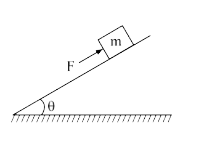The minimum force required to move a body up an inclined plane is three times the minimum force required to prevent it from sliding down the plane. If the coefficient of friction between the body and the inclined plane is 12√3, the angle of the inclined plane is
60∘
45∘
30∘
15∘
The correct Answer is:C
To solve the problem, we need to find the angle of inclination (θ) of the inclined plane given the relationship between the forces acting on a body on the plane. Here’s a step-by-step breakdown of the solution:
Step 1: Understanding the Forces Acting on the Body
When a body is placed on an inclined plane, the gravitational force (mg) acting on it can be resolved into two components:
- Perpendicular to the incline: mgcosθ
- Parallel to the incline: mgsinθ
Step 2: Setting Up the Equations
1. The limiting frictional force (F_L) that prevents the body from sliding down the incline can be expressed as:
FL=μN=μ(mgcosθ)
where μ=12√3.
2. Therefore, substituting for N:
FL=12√3(mgcosθ)
Step 3: Minimum Force to Prevent Sliding Down
To prevent the body from sliding down, the force of gravity acting down the incline must be balanced by the frictional force and the applied force (F_1):
mgsinθ=F1+FL
Substituting FL:
mgsinθ=F1+12√3(mgcosθ)
Step 4: Expressing F_1
Rearranging the equation gives:
F1=mgsinθ−12√3(mgcosθ)
Step 5: Minimum Force to Move Up the Incline
The minimum force required to move the body up the incline (F_2) is given as three times the minimum force to prevent sliding down:
F2=3F1
Step 6: Setting Up the Equation for F_2
When moving up the incline, the friction acts in the opposite direction:
F2=mgsinθ+FL
Substituting for FL:
F2=mgsinθ+12√3(mgcosθ)
Step 7: Equating F_2 with 3F_1
Now, substituting F2 and F1 into the equation:
mgsinθ+12√3(mgcosθ)=3(mgsinθ−12√3(mgcosθ))
Step 8: Simplifying the Equation
Dividing through by mg (assuming mg≠0):
sinθ+12√3cosθ=3sinθ−32√3cosθ
Rearranging gives:
sinθ+12√3cosθ+32√3cosθ=3sinθ
sinθ+2√3cosθ=3sinθ
2√3cosθ=2sinθ
Step 9: Finding the Angle θ
Dividing both sides by 2:
1√3cosθ=sinθ
This can be rewritten as:
tanθ=1√3
Thus, the angle θ is:
θ=30∘
Final Answer
The angle of the inclined plane is θ=30∘.
When a body is placed on an inclined plane, the gravitational force (mg) acting on it can be resolved into two components:
- Perpendicular to the incline: mgcosθ
- Parallel to the incline: mgsinθ
1. The limiting frictional force (F_L) that prevents the body from sliding down the incline can be expressed as:
FL=μN=μ(mgcosθ)
where μ=12√3.
FL=12√3(mgcosθ)
To prevent the body from sliding down, the force of gravity acting down the incline must be balanced by the frictional force and the applied force (F_1):
mgsinθ=F1+FL
Substituting FL:
mgsinθ=F1+12√3(mgcosθ)
Rearranging the equation gives:
F1=mgsinθ−12√3(mgcosθ)
The minimum force required to move the body up the incline (F_2) is given as three times the minimum force to prevent sliding down:
F2=3F1
When moving up the incline, the friction acts in the opposite direction:
F2=mgsinθ+FL
Substituting for FL:
F2=mgsinθ+12√3(mgcosθ)
Now, substituting F2 and F1 into the equation:
mgsinθ+12√3(mgcosθ)=3(mgsinθ−12√3(mgcosθ))
Dividing through by mg (assuming mg≠0):
sinθ+12√3cosθ=3sinθ−32√3cosθ
sinθ+12√3cosθ+32√3cosθ=3sinθ
sinθ+2√3cosθ=3sinθ
2√3cosθ=2sinθ
Dividing both sides by 2:
1√3cosθ=sinθ
This can be rewritten as:
tanθ=1√3
Thus, the angle θ is:
θ=30∘
The angle of the inclined plane is θ=30∘.
Similar Questions
The force required to move a body up a rough inclined plane is double the force required to prevent the body from sliding down the plane. The coefficient of friction when the angle of inclination of the plane is 60∘ is .
View SolutionIn the situation shown, the force required to just move a body up an inclined plane is double the force required to just prevent the body from sliding down the plane. The coefficient of friction between the block and plane is μ. The angle of inclination of the plane from horizontal is given by :

View Solution
Knowledge Check
Starting from rest, a body slides down a 45∘ inclined plane in twice the time it itakes to slide the same distance in the absence of friction.
They the coefficient of friction between the body and the inclined plane isA1/4B2/3C3/4D√3/2
The force required just to move a body up an inclined plane is double the force required just to prevent the body sliding down. If the coefficient of friction is 0.25, what is the angle of inclination of the plane ?
View SolutionThe force F1 required to just moving a body up an inclined plane is double the force F2 required to just prevent the body from sliding down the plane. The coefficient of friction is μ. The inclination θ of the plane is :
View SolutionThe force required to just move a body up the inclined plane is double the force required to just prevent the body from sliding down the plane. The coefficient of friction is μ. If θ is the angle of inclination of the plane than tanθ is equal to
View SolutionA body of mass m is kept on an inclined plane . The force required to just move a body up the inclined plane is double the force required to just prevent the body from sliding down the plane. If the coefficient of friction is μ, what is the inclination of the plane ?
View SolutionStarting from rest , a body slides down at 45∘ inclined plane in twice the time it takes to slide down the same distance in the absence of friction. The coefficient of friction between the body and the inclined plane is
View SolutionStarting from rest a body slides down a 45∘ inclined plane in twice the time it takes to slide down the same distance in the absence of friction. The coefficient of the body and the inclined plane is :
View SolutionIf the angle of inclination of the inclined plane is sin−1(12) when the body just starts sliding find the angle of repose and coefficient of static friction between the body and the inclined plane.
View Solution
